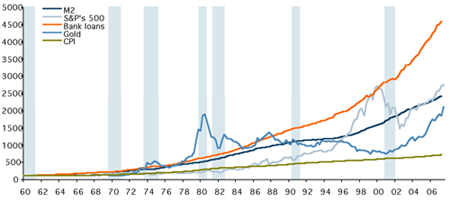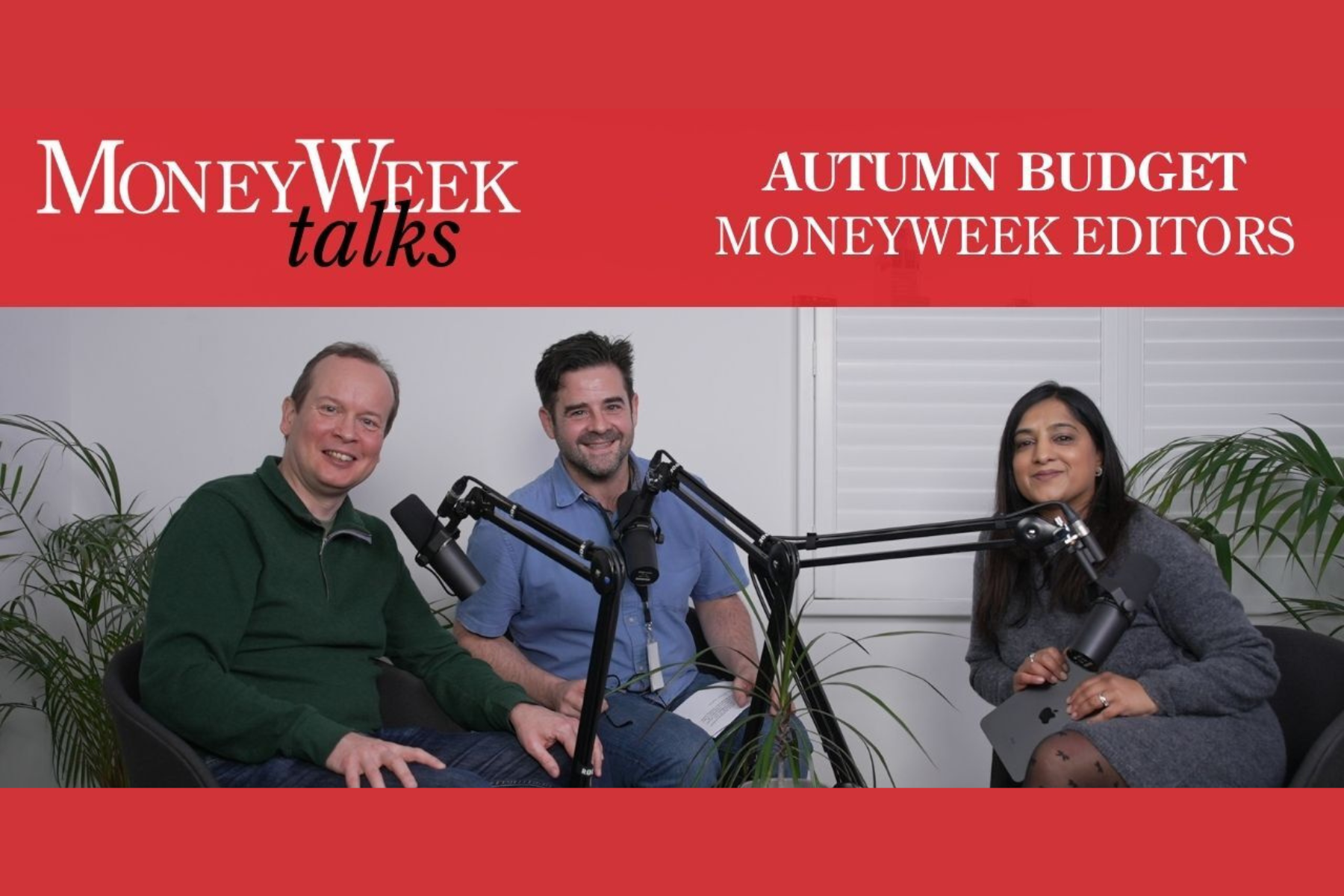Why gold still looks cheap
After years of neglect, the dollar price of gold is hitting 28-year highs. Yet when you consider that the 'real' price of gold was as high as $5000 back in the early 80s, gold has much further to climb.
Since the end of April 2001, the US dollar price of a troy ounce of gold has risen from US$264 to US$747 as of October 1, 2007 (Fig. 1) (November 1 spot is $783); in that period, gold has even 'outperformed' the US stock market.
To put it in less pleasant terms: the exchange value of the US dollar vis--vis gold the world's ultimate, freely chosen means of payment has fallen considerably in the time span under review.
Why, after years of the market's neglect of gold, is the paper money price of gold now on the rise?
MoneyWeek
Subscribe to MoneyWeek today and get your first six magazine issues absolutely FREE

Sign up to Money Morning
Don't miss the latest investment and personal finances news, market analysis, plus money-saving tips with our free twice-daily newsletter
Don't miss the latest investment and personal finances news, market analysis, plus money-saving tips with our free twice-daily newsletter
Would it be too far-fetched to assume that it could reflect market agents' growing concern about a forthcoming great inflation of government controlled paper money?

Source: Thomson Financials, Bloomberg, Federal Reserve Bank of St. Louis; own calculations. The series were indexed, with 1960-Q1 = 100. The shaded areas represent recession periods as defined by the NBER.
Tensions in credit markets might indeed provoke fears that central banks could, by way of lowering interest rates, pump even more credit and money into the economies, in an attempt to fend off a credit crisis and potential losses in output and employment.
Mainstream economists may be relaxed about such a policy provided 'inflation' typically defined as a change in the consumer price index remains 'low.' Austrians, in contrast, not only consider an increase in credit and money supply inflationary; they would also point out that the very process of a relentless increase in government-sponsored credit and money supply is a recipe for disaster, that it will ultimately end in the destruction of the currency.
Inflation: mainstream versus Austrian view
It all starts with peoples' understanding of inflation. Today, inflation is commonly understood as an ongoing, persistent rise in the economy's price level. Such a definition is based on the 'index regime' put forward by Irving Fisher (18671947). Here, price-level stability is understood as a rise in the economy's price level usually represented by a consumer price index of less than or around 2% on an annual basis. If inflation remains around this level, people are said to enjoy price (level) stability.
Austrian-minded economists would reject such a definition as erroneous and even denounce it as a deliberate attempt to confuse the public about the very forces at the heart of the erosion of the exchange value of money.
They would point out that money is a means of exchange, and that any change in its supply necessarily influences money's exchange value vis--vis goods and services.
Take, for instance, an economy in which the money stock is kept constant. To get hold of additional money, market agents would have to exchange goods and services against money. A growing supply of vendible items relative to the money supply would work towards reducing their prices in money terms.
Now consider the case in which an economy's stock of money can be increased through bank-credit expansion the feature of today's government-controlled money-supply monopolies. Market agents can obtain additional balances through bank loans without being obliged to surrender scarce resources. The additional demand financed by the increased stock of money would lower the exchange value of money vis--vis tradable goods.
It is against this background that Ludwig von Mises not only defined inflation as an increase in money supply (and, consequently, deflation as a decline in the money stock); he also foresaw that the confusion about the very nature of inflation would work in favor of inflationism:
Inflation means increasing the quantity of money and bank notes in circulation and the quantity of bank deposits subject to check. But people today use the term 'inflation' to refer to the phenomenon that is an inevitable consequence of inflation, that is the tendency of all prices and wage rates to rise. The result of this deplorable confusion is that there is no term left to signify the cause of this rise in prices and wages. There is no longer any word available to signify the phenomenon that has been, up to now, called inflation. It follows that nobody cares about inflation in the traditional sense of the term.[1]
A money system doomed to fail
Nowadays central banks, the agents of governments' money-supply monopolies, are willingly supplying virtually any amount of credit and money demanded by market agents as long as consumer price inflation remains close to 'target levels.' However, such a monetary policy is inflationary from the Austrian viewpoint.
Inflation has not become visible to many, though. In recent years a strongly growing credit and money supply has increasingly inflated prices for stocks, real estate, etc., and has to a much lesser extent shown up in consumer prices. To make things worse, the ensuing 'asset price inflation' has been widely hailed as a 'wealth effect,' said to be positive for production and employment.
Like traditional consumer price inflation, asset price inflation can be expected to encourage misallocation of scarce resources, inducing malinvestment. What is more, an inflation boom can only be sustained if the illusory stimulating effects inflation provokes remain in place. If inflation slows down, the inflation boom would sooner or later collapse.
Austrian economists would diagnose that the relentless increase in credit and money supply is at the heart of the inflation boom; the rise in (asset) prices is just its symptom. So if credit and money supply growth slow down, it doesn't take much for Austrians to expect a recession, even deflation.
However, recession and deflation undeniably costly in terms of a loss in output and employment would be the economic adjustment processes needed for bringing the economy back to equilibrium via changes in relative prices.
It would not take much to expect that government-controlled central banks, when having to decide between keeping inflation in check or preventing recession, would most likely opt for growth, whatever it takes, even at the expense of a loss in the purchasing power of money.
Once the crisis unfolds, or is merely feared to unfold, the public starts calling for even lower interest rates and even more credit and money. 'Cheap' credit and money is widely seen as a recipe for avoiding recession and deflation. Central bankers are unlikely to stand in the way of such calls.
All the more so as mainstream economics would consider the lowering of interest rates whatever the effects on credit and money supply might be a policy of 'best practice' as long as consumer price inflation remains within an 'acceptable level.'
The real value of gold
Current credit market turbulences are not only a direct result of an (asset price) inflationary monetary policy delivered in the past. The unfolding symptoms of the crisis that is, growing concerns about the solidity of the banking sector and the outlook for economic growth are also paving the way for an even more inflationary policy.
Against this background it is no wonder that investor interest in gold has returned. To what level might the paper-money price for gold rise? Those expecting hyperinflation would expect the exchange value of paper money against gold to approach, or become, zero.
What about those who expect inflation to become high, but not so high that it would make paper money lose its money function altogether? Clearly, this question is rather difficult, if not impossible, to answer. The more recent monetary history might provide some guidance, though.
The latest experience with 'unacceptably' high consumer price inflation was in the early 1970s and 1980s, when people become concerned about the reliability of the 'unfettered' government paper money standard. So what was the equivalent of the gold price in today's US-dollar purchasing power back then?
Mainstream economists would use the consumer price index to deflate the nominal US-dollar price of gold to come up with a 'real' that is inflation-adjusted US-dollar price of gold. Using the CPI for deflating the nominal US-dollar gold price would suggest a 'real' gold price of around US$1,700 in the early 1980s.
However, Austrians may prefer to use the stock of money, or the stock of bank credit, as an appropriate measure of inflation. Deflating the nominal US-dollar price of gold by the stock of M2 and bank credit, respectively, would suggest that the real gold price rose to US$3,000 and US$5,000, respectively, in the early 1980s.

Source: Thomson Financials, Bloomberg, Federal Reserve Bank of St. Louis; own calculations. The nominal gold price in US-dollar was deflated with the various measures of the loss of purchasing power of the US-dollar, using 2007-Q2 as the base year; last data point shown: 1 October 2007.
Against this background, the current US-dollar price of gold would, despite the recent price increase, still appear to be cheap. Even if hyperinflation seems to be a remote, even unlikely, scenario to many at this juncture, Mises looked through human beings' rational ignorance vis--vis the government-controlled paper money and his words could be taken as a support for the possibility that gold may well continue its appreciation vis--vis paper money:
But then finally the masses wake up. They become suddenly aware of the fact that inflation is a deliberate policy and will go on endlessly. A breakdown occurs. The crack-up boom appears. Everybody is anxious to swap his money against 'real' goods, no matter whether he needs them or not, no matter how much money he has to pay for them. Within a very short time, within a few weeks or even days, the things which were used as money are no longer used as media of exchange. They become scrap paper. Nobody wants to give away anything against them.[2]
By Thorsten Polleit, Honorary Professor at the Frankfurt School of Finance & Management, for the Mises Institute, www.mises.org
Get the latest financial news, insights and expert analysis from our award-winning MoneyWeek team, to help you understand what really matters when it comes to your finances.
MoneyWeek is written by a team of experienced and award-winning journalists, plus expert columnists. As well as daily digital news and features, MoneyWeek also publishes a weekly magazine, covering investing and personal finance. From share tips, pensions, gold to practical investment tips - we provide a round-up to help you make money and keep it.
-
 How much would it cost you to buy a house in Great Britain's happiest places?
How much would it cost you to buy a house in Great Britain's happiest places?Average asking prices for a property in the happiest place in Britain are below the national average
-
 How the Budget will hurt you: MoneyWeek Talks
How the Budget will hurt you: MoneyWeek TalksPodcast An Autumn budget podcast special episode, featuring MoneyWeek editors Kalpana Fitzpatrick, Andrew van Sickle and Cris Heaton.

